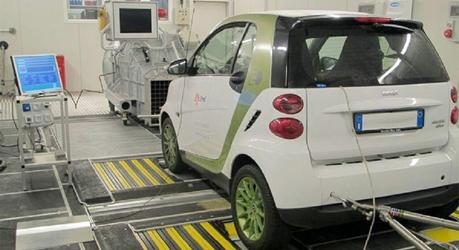 Testing of e-vehicle. JRC has upgraded its facilities to study the static and dynamic behaviours of evolving power grids integrating more renewables, electric vehicles, dispersed energy resources and storage. (Credit: EU, 2013)
Testing of e-vehicle. JRC has upgraded its facilities to study the static and dynamic behaviours of evolving power grids integrating more renewables, electric vehicles, dispersed energy resources and storage. (Credit: EU, 2013)The goal of the first of the two twin centers is to advance common standards for electric vehicles and smart grid infrastructure on both sides of the Atlantic. Converging standards and interoperability between smart grids and electric vehicles will allow for deeper penetration of renewable energies in the electricity systems, thus facilitating the way to a low-carbon economy. Technology harmonization will drive product and service innovation in the two world’s largest economies and could prove instrumental in establishing global standards for electric mobility.
The launch of the Interoperability Center for electric vehicles and smart grids is the fruit of 18 months of dedicated work following the Letter of Intent (LoI) for closer co-operation, signed by the JRC, the European Commission’s in-house science service, and the US Department of Energy (DOE) in 2011. The Interoperability Center inaugurated last week is hosted at DOE’s Argonne National Laboratory near Chicago. The second Center will be opened in the EU, at the JRC sites in Petten, The Netherlands and Ispra, Italy, in 2014.
The interaction between smart grids—intelligent electricity systems—and electric vehicles will ensure economically efficient, sustainable power systems with low losses and high security of supply and safety. Smart grids, as upgraded electricity networks, will provide a two-way digital communication between supplier and consumer which will predict and respond to the actions of all users connected to the grid.
Standardization in this field will benefit the European energy landscape while converging transatlantic technical regulations could lead the way to global standards. The trade and investment agreement currently negotiated by the EU and the US—known as the Transatlantic Trade and Investment Partnership (TTIP)—aims to remove tariffs and differences in technical regulations, standards and certifications which cost time and money to companies and consumers. In the context of the importance of this agreement for converging standards across the Atlantic, the work of the twin Interoperability Centers will play a scene-setting role for technology harmonization in the two biggest world economies.

